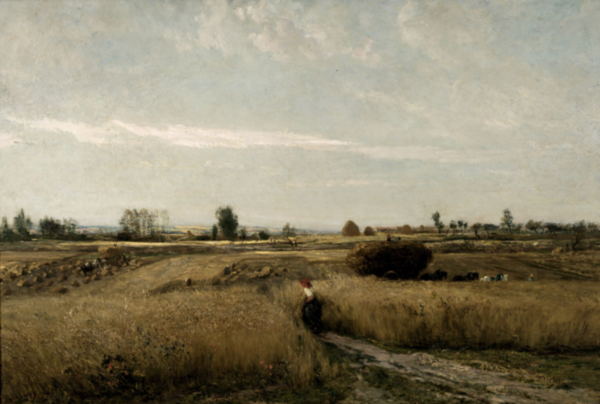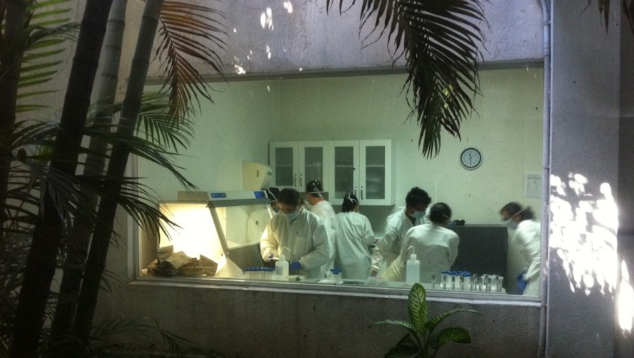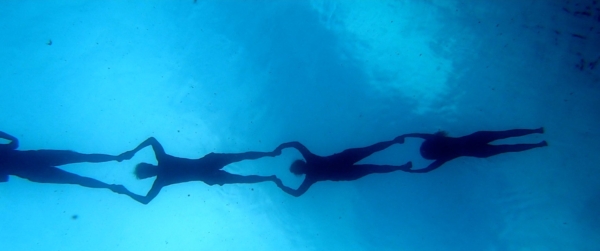
Paysages et paysans, Quand l’art raconte le climat – Musée départemental des peintres de Barbizon
Dans le cadre de l’opération nationale "100 œuvres qui racontent le climat", le musée départemental des peintres de Barbizon met…

Forensis In the framework of The Anthropocene Project 2013–2014
March 15–May 5, 2014
- Opening: March 14, 6pm with performance Pythagorean lecture « Tthe irreducible surplus matter », by Grupa Spomenik / Monument. Group.
– Conference: « The Architecture of Public Truth » March 15–16 / Haus der Kulturen der Welt (John-Foster-Dulles-Allee 10 10557 Berlin Germany).
From DNA analysis to tracking Internet activities, forensics is central to the ways by which states police and govern their subjects. The exhibition interrogates the « forensic turn » manifested in contemporary popular culture, as well as in juridical culture in courtrooms, human rights investigations, and international forums for justice. One of the starting points of this turn was the identification of the remains of Joseph Mengele in Brazil in 1985 and the subsequent forensic exhumations of victims of the « Dirty War » in Argentina in the mid-1980s. The political aesthetics of forensics shifts across several registers—from persons to matter, from the survivor and victim to the human remains, to material and digital traces. It also involves a turn from the human to the environment, from figure to ground. The increasingly destructive entanglement of human and natural forces in the age of climate change poses major challenges to the classical figurations inherent to law and human rights. Whereas criminal law seeks to establish a linear or causal relation between perpetrator and victim, between violent actions and material traces, « field causalities » are inherently relational, non-linear, and diffused over space and time.
Exhibition
The exhibition Forensis seeks to critically interrogate the emergent forensic aesthetics and suggest ways of inverting the forensic gaze—from the state policing its subjects to subjects policing the state. Forensis thus designates a field of action in which individuals and independent organizations in situations of political struggle and violent conflict can confront crimes of states, corporations, or other political actors. The exhibition encompasses both investigations that chart new territories in making use of forensic methods and technologies, and critical reflection on the use of forensics and its political bearings. As an exhibition, Forensis presents not just research materials, but moves beyond the symbolic field of art exhibitions by producing legally relevant and consequential material that serves as evidence in political forums and courts. It presents the work of the architects, artists, filmmakers, and theorists who make up the Forensic Architecture project at the Centre for Research Architecture at Goldsmiths, University of London, as well as that of its close collaborators and guests.
Conference
The conference « The Architecture of Public Truth » brings together the fields of law and aesthetic production. Artists, writers, lawyers, judges, activists, theorists, and architects will raise questions about recent transformations in the conditions under which spatial and material evidence is recorded and presented. The conference sets out to explore ways in which new kinds of engagement with the materiality of politics might open new political possibilities and shift existing fields of knowledge. The panels will explore a wide range of issues and scales: from the human body, through buildings and territories, to the scale of the planet as the ultimate forensic object, which human-induced climate change has transformed into both a construction site and a ruin. The conference includes contributions by, among others: novelist Jonathan Littell (The Kindly Ones); Luis Moreno Ocampo, the first Prosecutor of the International Criminal Court in The Hague; legal theorist Brenna Bhandar; Baltasar Garzón, Spanish jurist who indicted Augusto Pinochet and present legal advisor to Julian Assange; Al Jazeera producer Marcela Pizzaro; media scholar and artist Susan Schuppli; geo-philosopher Kathryn Yusoff; Michael Sfard, Israel’s foremost human rights lawyer; and Wolfgang Kaleck, General Secretary of the European Center for Constitutional and Human Rights, who has recently submitted a Communication to the International Criminal Court against British war crimes in Iraq.
The exhibition includes contributions by Lawrence Abu Hamdan, Nabil Ahmed, Maayan Amir, Anthropocene Observatory (Anselm Franke, Armin Linke, Territorial Agency / John Palmesino and Ann-Sofi Rönnskog), Jacob Burns, Gabriel Cuéllar, DAAR (Alessandro Petti, Sandi Hilal, Eyal Weizman), Forensic Oceanography (Charles Heller, Lorenzo Pezzani), Grupa Spomenik (Damir Arsenijević, Ana Bezić, Pavle Levi, Jelena Petrović, Branimir Stojanović, Milica Tomić), Ayesha Hameed, Samir Harb, Helene Kazan, Thomas Keenan, Steffen Kraemer, Adrian Lahoud, Model Court (Lawrence Abu Hamdan, Sidsel Meineche Hansen, Lorenzo Pezzani, Oliver Rees), Modelling Kivalina (Andrea Bagnato, Daniel Fernández Pascual, Helene Kazan, Hannah Meszaros Martin, Alon Schwabe), Gerald Nestler, Godofredo Pereira, Nicola Perugini, ScanLAB Projects (Matthew Shaw, William Trossell), Susan Schuppli, Francesco Sebregondi, Shela Sheikh, SITU Research (Robert Beach, McKenna Cole, Therese Diede, Akshay Mehra, Charles-Antoine Perrault, Bradley Samuels, Xiaowei Wang), Caroline Sturdy Colls, Paulo Tavares, Srdjan Jovanovic Weiss/NAO, Eyal Weizman and Ines Weizman.
Curated by Anselm Franke and Eyal Weizman The Anthropocene Observatory’s third episode, Down to Earth, is part of the Forensis exhibition, and opens at the same time. It is a project by Armin Linke, Territorial Agency (John Palmesino, Ann-Sofi Rönnskog), and Anselm Franke. Forensis is part of the Anthropocene Project 2013–2014 at Haus der Kulturen der Welt. Forensis emerges out of the European Research Council funded project, Forensic Architecture based at the Centre for Research Architecture, Department of Visual Cultures, Goldsmiths, University of London. Forensis is a co-production of Haus der Kulturen der Welt, funded by the Capital Cultural Fund, and Forensic Architecture, funded by the European Research Council. The education program is run in collaboration with the European Center for Constitutional and Human Rights (ECCHR), and supported by the Embassy of Argentina. Haus der Kulturen der Welt is supported by the Federal Government Commissioner for Culture and the Media as well as by the Federal Foreign Office.
More informations:
www.hkw.de
Press contact:
Anne Maier
T +49 30 39787 153
anne.maier(at)hkw.de
Dans le cadre de l’opération nationale "100 œuvres qui racontent le climat", le musée départemental des peintres de Barbizon met…
Dans le cadre de la Biennale des Arts et de l’Océan organisée par la Ville de Nice, et en écho…
Dans le cadre de la Biennale des Arts de la Ville de Nice 2025 et à l’occasion de l’accueil à…

